The NVIDIA GeForce GTX 780 Ti Review
by Ryan Smith on November 7, 2013 9:01 AM ESTOverclocking
Finally, let’s spend a bit of time looking at the overclocking prospects for the GTX 780 Ti. Although GTX 780 Ti is now the fastest GK110 part, based on what we've seen with GTX 780 and GTX Titan there should still be some headroom to play with. Meanwhile there will also be the matter of memory overclocking, as 7GHz GDDR5 on a 384-bit bus presents us with a new baseline that we haven't seen before.
| GeForce GTX 780 Ti Overclocking | ||||
| Stock | Overclocked | |||
| Core Clock | 876MHz | 1026MHz | ||
| Boost Clock | 928MHz | 1078MHz | ||
| Max Boost Clock | 1020MHz | 1169MHz | ||
| Memory Clock | 7GHz | 7.6GHz | ||
| Max Voltage | 1.187v | 1.187v | ||
Overall our overclock for the GTX 780 Ti is a bit on the low side compared to the other GTX 780 cards we’ve seen in the past, but not immensely so. With a GPU overclock of 150MHz, we’re able to push the base clock and maximum boost clocks ahead by 17% and 14% respectively, which should further extend NVIDIA’s performance lead by a similar amount.
Meanwhile the inability to unlock a higher boost bin through overvolting is somewhat disappointing, as this is the first time we’ve seen this happen. To be clear here GTX 780 Ti does support overvolting – our card offers up to another 75mV of voltage – however on closer examination our card doesn’t have a higher bin within reach; 75mV isn’t enough to reach the next validated bin. Apparently this is something that can happen with the way NVIDIA bins their chips and implements overvolting, though this the first time we’ve seen a card actually suffer from this. The end result is that it limits our ability to boost at the highest bins, as we’d normally have a bin or two unlocked to further increase the maximum boost clock.
As for memory overclocking, we were able to squeeze out a bit more out of our 7GHz GDDR5, pushing our memory clock 600MHz (9%) higher to 7.6GHz. Memory overclocking is always something of a roll of the dice, so it’s not clear here whether this is average or not for a GK110 setup with 7GHz GDDR5. Given the general drawbacks of a wider memory bus we wouldn’t be surprised if this was average, but at the same time in practice GK110 cards haven’t shown themselves to be as memory bandwidth limited as GK104 cards. So 9%, though a smaller gain than what we’ve seen on other cards, should still provide GTX 780 Ti with enough to keep the overclocked GPU well fed.
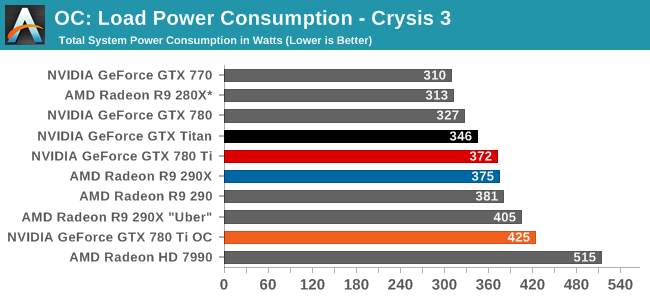
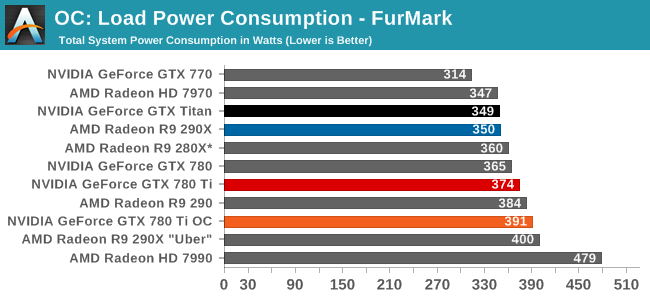
Starting as always with power, temperatures, and noise, we can see that overclocking GTX 780 Ti further increases its power consumption, and to roughly the same degree as what we’ve seen with GTX 780 and GTX Titan in the past. With a maximum TDP of just 106% (265W) the change isn’t so much that the card’s power limit has been significantly lifted – as indicated by FurMark – but rather raising the temperature limit virtually eliminates temperature throttling and as such allows the card to more frequently stay at its highest, most power hungry boost bins.
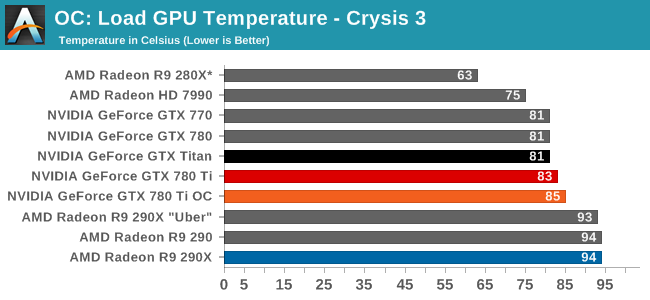

Despite the 95C temperature target we use for overclocking, the GTX 780 Ti finds its new equilibrium point at 85C. The fan will ramp up long before it allows us to get into the 90s.
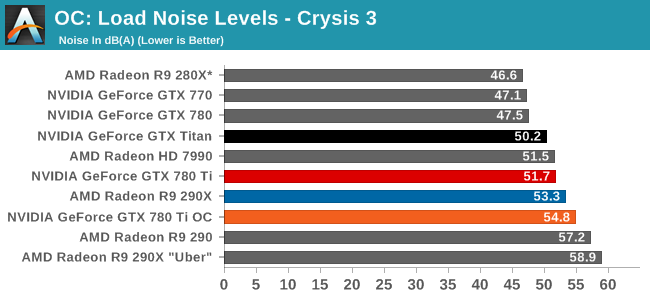
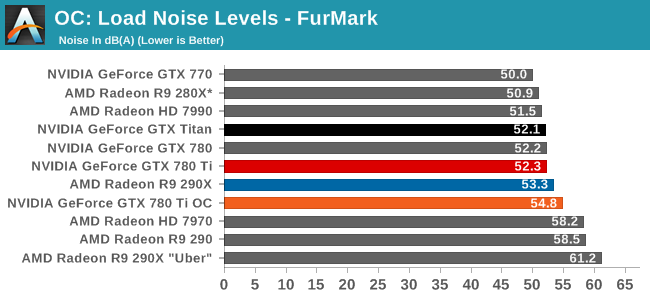
Given the power jump we saw with Crysis 3 the noise ramp up is surprisingly decent. A 3dB rise in noise is going to be noticeable, but even in these overclocked conditions it will avoid being an ear splitting change. To that end overclocking means we’re getting off of GK110’s standard noise efficiency curve just as it does for power, so the cost will almost always outpace the payoff on a relative basis.
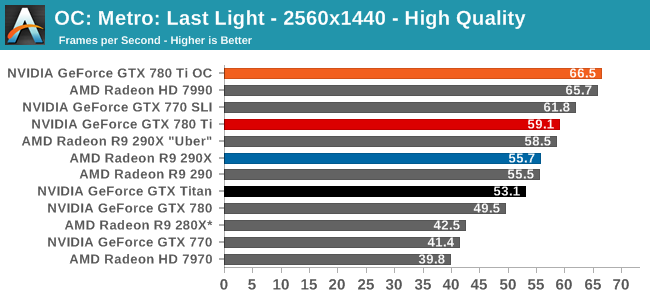
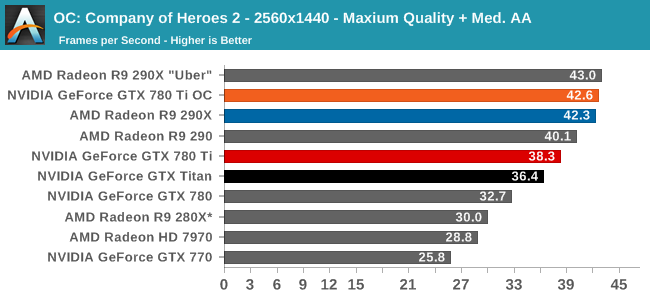
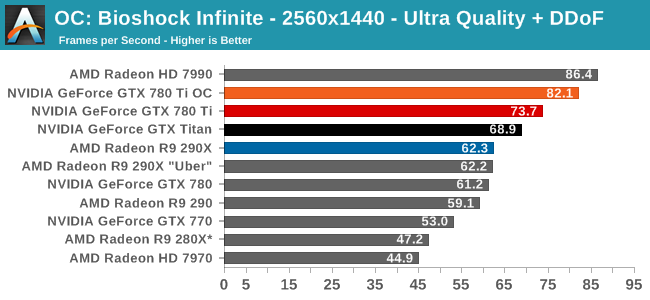
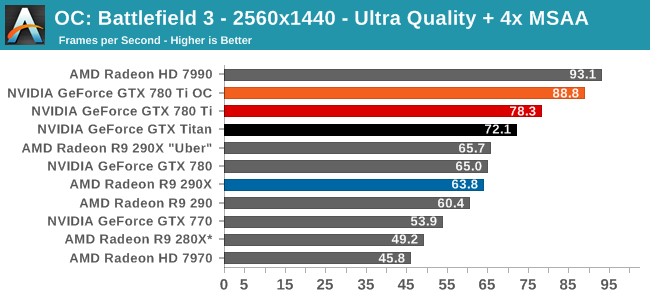
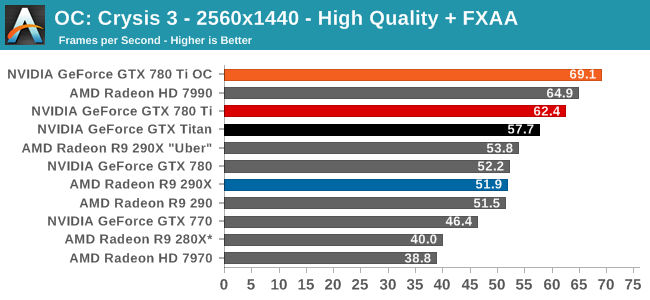
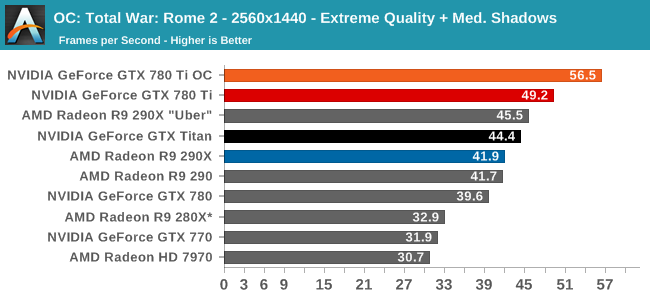
Finally, looking at gaming performance the the overall performance gains for overclocking are generally consistent. Between our 6 games we see a 10-14% performance increase, all in excess of the memory overclock and closely tracking the GPU overclock. GTX 780 Ti is already the fastest single-GPU card, so this only further improves its performance lead. But it does so while cutting into whatever is above it, be it the games where the stock 290X has a lead, or multi-GPU setups such as the 7990.










302 Comments
View All Comments
Tetracycloide - Thursday, November 7, 2013 - link
Hardware vendors get much better prices than that which is why you so often find third party coolers on custom cards for a fairly modest markup ($10-20).nathanddrews - Friday, November 8, 2013 - link
The Arctic Accelero Xtreme III that Tom's used was only $70, but even if it was $100 extra, that's still a $150 gap. For vendors, subtract the cost of the bad cooler from the good cooler and I'll bet we see dual/tri-fan 290s for under $450.Also, this is interesting:
http://www.tomshardware.com/reviews/radeon-r9-290-...
Mithan - Thursday, November 7, 2013 - link
Great card, but about $150 over priced. I would purchase this for $550 right now, but $700? No.1Angelreloaded - Thursday, November 7, 2013 - link
Maxwell is due out next year, so tbh this would be a bad bandwagon to jump on, an architechure change and possible die shrink will come next year and depending on yields I would anticipate a 10-15% jump in the next series with lower tdp.kwrzesien - Thursday, November 7, 2013 - link
Maybe even at $600. $700? No.Nirvanaosc - Thursday, November 7, 2013 - link
Great review, but the Overclocking section still has the same text as the R9 290 review.piroroadkill - Thursday, November 7, 2013 - link
290 and 290X look even better in this when used in CF. They scale better than 780Ti in SLI.You can save even more with 290X CF than 780Ti, AND get better performance in almost every test listed.
With that setup you'd be wise in either case to get a nice custom cooling loop anyway.
Gast - Thursday, November 7, 2013 - link
1st paragraph of the conclusion. "NVIDIA’s high-end cards a bit faster and a big cheaper each time."Should be "a bit cheaper each time".
Pneumothorax - Thursday, November 7, 2013 - link
Sad, this goes to show that Nvidia was selling us mid-range Keplers all last year at premium prices. This card is what the GTX 680 should've been all along. OTOH, if the 7970 was priced much better out of the gate, it might've forced the green team not to have ripped us off so much.EJS1980 - Thursday, November 7, 2013 - link
If Nvidia released this as their answer to the 7970, AMD would have simply gone out of business. Maybe AMD should thank NVidia for showing them mercy, and keeping them afloat...j/k!